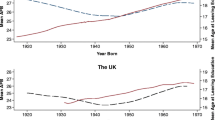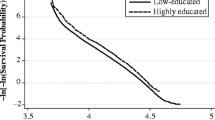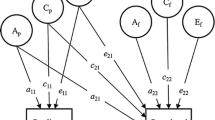Abstract
Using data on monozygotic (MZ) (identical) female twins from the Minnesota Twin Registry, we estimate the causal effect of schooling on completed fertility, probability of being childless, and age at first birth using the within-MZ twins methodology. We find strong cross-sectional associations between schooling and the fertility outcomes, and some evidence that more schooling causes women to have fewer children and delay childbearing, though not to the extent that interpreting cross-sectional associations as causal would imply. Our conclusions are robust when taking account of (1) endogenous within-twin pair schooling differences due to reverse causality and (2) measurement error in schooling. We also investigate possible mechanisms and find that the effect of women’s schooling on completed fertility is not mediated through husband’s schooling but may be mediated in part through age at first marriage.
Similar content being viewed by others
Notes
One exception is that of McCrary and Royer (2011). They exploit the fact that school entry dates in California and Texas are a function of date of birth: children aged 5 on December 1 (California) or September 1 (Texas) can start their first year of kindergarten, while others have to delay their entrance by 1 year. They compare outcomes for women born just before and after the school entry dates and find no significant effect of schooling on age at first birth.
For example, the event dropout rate (percent of 9th to 12th graders who dropped out) during 2008–2009 academic year for whites in Minnesota was 1.2, whereas the national average was 2.7 (National Center for Education Statistics 2008; http://nces.ed.gov/programs/digest/d11/tables/dt11_114.asp).
This approach is advantageous relative to an alternative tabulation of schooling differences by average twin pair schooling levels because, by construction, the mean difference in grades of schooling will tend to become small for twins pairs that either have very high or very low mean schooling levels.
For the twins listed in Appendix Table A1, we cannot, of course, be certain that fertility/marriage prevented schooling completion. These are essentially our own judgment calls.
In Appendix Table A1, there are 16 twin pairs listed where both fertility and marriage appear to have prevented schooling. In twin pair 77, both twins’ schooling appears to have been prevented by fertility and marriage. We exclude this pair from the regressions in panel C in Table 3, which is why the sample size for all twins and twin mothers is 403 and 313 pairs, respectively.
Linear probability models can yield predictions outside the unit interval. Our conclusions are robust to using conditional fixed-effects logit models. Our conclusions for the number of children are also robust to estimating the cross-sectional relationship with Poisson regressions and within-MZ twins estimates with Poisson fixed-effects.
We are not able to rule out this possibility as there is no information on infant mortality in the MTR. However, in our data, only 14 out of the 808 twins gave birth to twins, and only four twins that also had twins in the no-reverse-causality sample. Excluding these observations or adding a dummy variable to control for twin births in our regressions does not affect our conclusions. Results are available on request.
Consider a relation where measures of parental input such as educational expenditures for twin i in pair j (\(I_{ij})\) is related to the birth weight of twin i (bw\(_{ij})\), birth weight of the co-twin (bw\(_{kj})\), unobserved family variables(\(\mu \) \(_{j})\), and an error term (\(\xi \) \(_{ij})\): \(I_{ij}\) = \(\beta \textit {bw}_{ij}\) + \(\theta \)bw\(_{kj}\) + \(\mu \) \(_{j}\) + \(\xi \) \(_{ij}\). If \(\beta \) \(>\) 0 and \(\theta \) \(<\) 0, then parents reinforce differences between twins, whereas \(\beta \) \(<\) 0 and \(\theta \) \(>\) 0 imply that parents compensate for differences between twins. The within-MZ twin relation which eliminates the influence of unobserved common family factors is \(I_{1j}\) - \(I_{2j}\) = (\(\beta \) - \(\theta \))(bw\(_{1j}\) - bw\(_{2j})\) + (\(\xi \) \(_{1j}\) \(_{-}\) \(\xi \) \(_{2j})\). A reinforcement strategy by parents implies that (\(\beta \) - \(\theta \)) is positive, and compensation implies that (\(\beta \) - \(\theta \)) is negative.
They also find that the health shock leads to lower schooling. Lundborg et al. (2011) find that measures of adolescent health at age 18 do not predict schooling differences; so, again, the evidence is mixed.
Respondents in the MTR data set were asked a series of questions regarding schooling attainment, whereas in the CPS, respondents are only asked a single question: “What is your highest level of school completed or degree received?” The options and grades of schooling that we assign are (1) less than the first grade: 0 grades assigned; (2) first, second, third, or fourth grade: 2.5 grades assigned; (3) fifth or sixth grade: 5.5 grades assigned; (4) seventh or eighth grades:7.5 grades assigned; (5) ninth grades: 9 grades assigned; (6) tenth grade: 10 grades assigned; (7) 11th grade: 11 grades assigned; (8) 12th grade no diploma: 11 grades assigned; (9) high school graduate diploma or some college but no degree: 12 grades assigned; (10) some college but no degree:13 grades assigned; (11) associates degree: 14 grades assigned; (12) bachelor’s degree:16 grades assigned; (13) masters degree: 18 grades assigned; (14) professional school degree: 19 grades assigned; (15) doctorate degree: 20 grades assigned.
No measurement error-corrected IV estimates are presented for the nonlinear representation of schooling because, when binary variables are used, the measurement error is nonclassical. Individuals in the lowest educational category cannot under-report their education, and individuals in the top categories cannot over-report their education. Kane et al. (1999) show that, with multiple binary indicators of highest educational attainment, one cannot sign the bias in OLS and IV estimates due to measurement error.
References
Almond D, Currie J (2011). In: Ashenfelter O, Card D (eds) Handbook of labor economics. Elsevier, Amsterdam, pp 1315–1486
Antonovics K, Goldberger AS (2005) Does increasing women’s schooling raise the schooling of the next generation? Comment. Am Econ Rev 95:1738–1744
Ashenfelter O, Krueger A (1994) Estimates of the economic return to schooling from a new sample of twins. Am Econ Rev 84:1157–1173
Behrman JR, Rosenzweig MR (2002) Does increasing women’s schooling raise the schooling of the next generation? Am Econ Rev 92:323–334
Behrman JR, Rosenzweig MR (2004) Returns to birthweight. Rev Econ Stat 86:586–601
Behrman JR, Rosenzweig MR (2005) Does increasing women’s schooling raise the schooling of the next generation?—Reply. Am Econ Rev 95:1745–1751
Behrman JR, Rosenzweig MR, Taubman P (1994) Endowments and the allocation of schooling in the family and in the marriage market: the twins experiment. J Polit Econ 102:1131–1173
Behrman JR, Kohler HP, Jensen V, Pedersen D, Petersen I, Bingley P, Christensen K (2011) Does more schooling reduce hospitalization and delay mortality? New evidence based on Danish twins. Demography 48:1347–1375
Bishop J (1976) Reporting errors and the true return to schooling. Department of Economics, University of Wisconsin
Black SE, Devereux PJ, Salvanes KG (2007) From the cradle to the labor market? The effect of birth weight on adult outcomes. Q J Econ 122:409–439
Black SE, Devereus PJ, Salvanes KG (2008) Staying in the classroom and out of the maternity ward? The effect of compulsory schooling laws on teenage births. Econ J 118:1025–1054
Bound J, Solon G (1999) Double trouble: on the value of twins-based estimation of the return to schooling. Econ Educ Rev 18:169–182
Breierova L, Duflo E (2002) The impact of education on fertility and child mortality: do fathers really matter less than mothers? NBER Working Paper Number:10513
Brinch CN, Taryn GA (2012) Schooling in adolescence raises IQ scores. Proc Natl Acad Sci USA 109:425–430
Cascio EU, Ethan LG (2006) Schooling and the armed forces qualifying test. J Hum Resour 41:294–318
Conti G, Heckman J, Yi J, Zhang J (2011) Early health shocks, parental responses and child outcomes. Department of Economics, University of Hong Kong
Duflo E, Dupas P, Kremer M (2011) Education and fertility: experimental evidence from Kenya. MIT, Working Paper
Fort M, Schneeweis N, Winter-Ebmer R (2011) More schooling, more children: compulsory schooling reforms and fertility in Europe. IZA Discussion Paper Number:6015
Griliches Z (1979) Sibling models and data in economics: beginnings of a survey. J Polit Econ 87:37–64
Kane TJ, Rouse C, Staiger D (1999) Estimating returns to schooling when schooling is mismeasured. NBER Working Paper Number:7235
Kleinman JC, Fowler MG, Kessel SS (1991) Comparison of infant mortality among twins and singletons: United States 1960 and 1983. Am J Epidemiol 133:133–143
Kohler HP, Knudsen LB, Skytthe A, Christensen K (2002) The fertility pattern of twins and the general population compared: evidence from Danish cohorts 1945–64. Demogr Res 6:383–408
Kohler HP, Behrman JR, Schnittker J (2011) Identifying causation and the role of endowments: the use of twin studies in economics and behavioral genetics. Biodemogr Soc Biol 57:88–141
Lavy V, Zablotsky A (2011) Does increasing mother’s schooling reduce fertility and increase children’s education: evidence from a natural experiment on Arabs in Israel. NBER Working Paper Number:16850
Leon A (2004) The effect of education on fertility: evidence from compulsory schooling laws. Working Paper Number 288, University of Pittsburg
Lundborg P (2013) The health returns to schooling—what can we learn from twins? J Popul Econ 26:673–701
Lundborg P, Nilsson A, Olof-Rooth D (2011) Does early life health predict schooling within twin pairs? IZA Discussion Paper Number:5805
McCrary J, Royer H (2011) The effect of maternal education on fertility and infant health: evidence from school entry policies using exact date of birth. Am Econ Rev 101:158–195
Meghir C, Palme M, Simeonova E (2011) How does education affect labor market outcomes: the effect of schooling on cognitive and non-cognitive skills. Working Paper
Miller P, Mulvey C, Martin NG (2005) Birth weight and schooling and earnings: estimates from a sample of twins. Econ Lett 86:387–392
Monstad K, Propper C, Salvanes KG (2008) Education and fertility: evidence from a natural experiment. Scand J Econ 110:827–852
National Center for Education Statistics (2008) Public high school graduates and dropouts, by race/ethnicity and state or jurisdiction: 2008–2009. http://nces.ed.gov/programs/digest/d11/tables/dt11_114.asp. Accessed 22 May 2013
Osili O, Long BT (2008) Does female schooling reduce fertility? Evidence from Nigeria. J Dev Econ 83:446–465
Parisi P, Gatti M, Caperna G (1983) Familial incidence of twinning. Nature 304:626–628
Rosenzweig MR, Zhang J (2009) Do population policies induce more human capital investments? Twins, birth weight and China’s one-child policy. Rev Econ Stat 76:1149–1174
Royer H (2009) Separated at girth: US twin estimates of the effects of birth weight. Am Econ J Appl Econ 1:49–85
Sandewall Ö, Cesarini D, Johannesson M (2009) The co-twin methodology and returns to schooling—testing a critical assumption. Research Institute of Industrial Economics Working Paper Number 806
Author information
Authors and Affiliations
Corresponding author
Additional information
Responsible editor:
Junsen Zhang
Electronic supplementary material
Rights and permissions
About this article
Cite this article
Amin, V., Behrman, J.R. Do more-schooled women have fewer children and delay childbearing? Evidence from a sample of US twins. J Popul Econ 27, 1–31 (2014). https://doi.org/10.1007/s00148-013-0470-z
Received:
Accepted:
Published:
Issue Date:
DOI: https://doi.org/10.1007/s00148-013-0470-z




